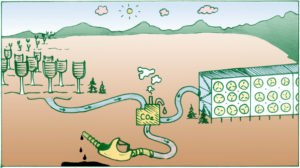Founded almost 40 years ago with the financial support of the MacArthur Foundation, the World Resources Institute (WRI) is one of the U.S most prominent research organizations working on environmental issues since its inception. The entity centers its efforts on scientific research and development while explicitly ignoring “ideology” or fostering activism. WRI has a wide range of scientific publications that have made outstanding contributions to the field over the years.
Last month, WRI published a paper, the 4th of an ongoing series, identifying the policies and technologies the U.S. will need to adopt to undertake carbon removal at scale. The publication offers four broad options, each discussed in detail, backed by relevant research and data, and linked to clear investment strategies and financial implications. As I see it, this paper will also be beneficial to the team that has a rather large blind spot when it comes to grasping the dynamics of climate change. This research is an excellent example of evidence-based policymaking.
My interest in the paper is much less ambitious. I do not need to be convinced about the acuteness of the climate crisis. I am however curious about the climate technologies WRI is putting forward and the eventual amount of carbon that they could remove from the atmosphere in a best-case scenario.
Using the data and analysis offered by the paper, I have compiled the table below.
Since the paper is focused on carbon removal, Solar Radiation Management (SRM) and associates do not make the cut as these technologies do not remove carbon. Instead, their goal is to reduce solar radiation in several different ways. Perhaps more controversial is the exclusion of Carbon Capture and Storage (CCS) seen here as a technology servicing the fossil fuel industry. While this is undoubtedly the case, the question is if CSS could also be used for other purposes by other sets of actors in the short term. The research does not explore such a possibility.
WRI endorses eight carbon removal technologies that include both natural climate and geoengineering options. Combined in various ways, this group of eight yields four possibilities. The first is limiting the choices to natural climate technologies. The flip side is using only geoengineering. Putting all the eggs into the Direct Air Capture (DAC) option is the third – although one has to wonder why DAC should be prioritized in this fashion. Embracing all of them together is the last one.
However, policy options suggested by the paper are a factor of the actual level of development of a given technology and its capacity to remove carbon from the atmosphere. Reforestation and DAC are most promising and are called Staples. Next is Carbon Farming or Agricultural Soil Carbon aggregated under the No Regrets rubric. Carbon Mineralization and Enhanced Root Crops are named Speculative Bets. And the last three comprise Supplemental Pathways. Perhaps missing in this picture is the possibility that new and more adequate climate technologies could emerge in the next 10 to 20 years. In this light, having a climate innovation fund could be a way to promote this while setting specific requirements.
The table above clearly depicts the fact that the carbon removal capacity of this set of technologies has a wide range. Tree reforestation and DAC are expected to have the most significant impact accounting for 60 percent of all carbon removal by 2050, using the best-case scenarios presented by the paper. Combining all the technologies together will remove 24 gigatons of carbon from the atmosphere by the same year. Estimates per year are not easy to generate as some of these technologies are still evolving and timing vis-a-vis natural-based solutions is not the same. The latter will kick-off in 2030 whereas all geoengineering solutions will only enter the scene in 2040.
U.S. territorial carbon emissions are just over 5 gigatons per year. By 2050 another 60 gigatons could be emitted by the country, albeit the U.S. trend line points to a decrease for the last five years or so. If we assume that the eight technologies endorsed by WRI were to start acting in concert from day 1, then the maximum carbon removal will be 2,85 gigatons, over half of the current emissions. While not sufficient, that could be a good start, provided policymakers have the appetite to take action on the subject.
Financially, selecting all of the options together will demand an investment of almost 60 billion USD for the next ten years. Certainly not a hefty bill, but then again, the intention here is not to develop a comprehensive “Green New Deal.” Instead, the idea to entice current policymakers to get the climate ball rolling now. That, however, does not imply that a Green Deal is not needed.
Cheers, Raúl








Comments
One response to “Carbon Removal Policies for the U.S?”